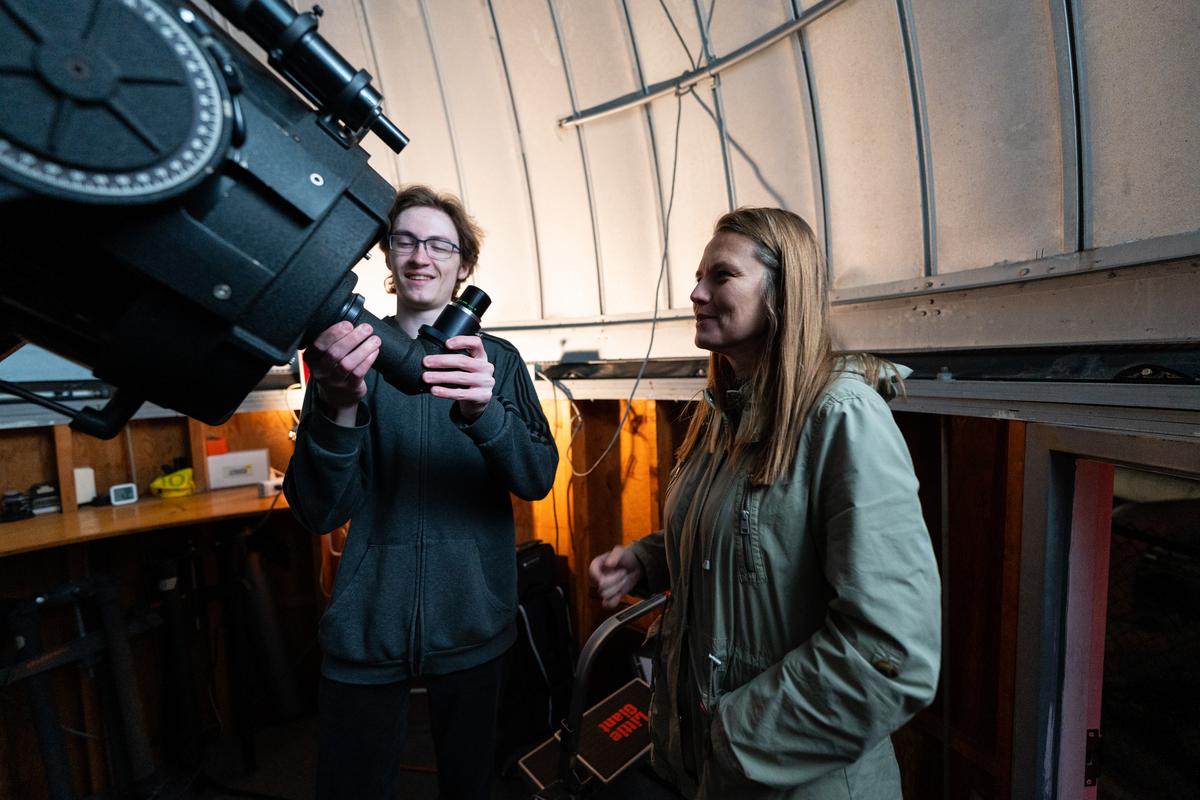What to Expect from April 8’s Solar Eclipse With President of Arcadia’s Astronomy Club, Paul Broccardi ’24

On April 8, a solar eclipse will be visible from Arcadia University’s campus. To prepare for this astronomical event, Dr. Tatjana Miletic, associate professor and chair of the Chemistry and Physics department, and Paul Broccardi ’24, president of Arcadia’s Astronomy Club, teamed up to help the Arcadia community know what to expect from this eclipse.
“This is a rare event,” said Broccardi. “The next solar eclipse where the path of totality will cross over the state of Pennsylvania won’t happen until the year 2144. Probably not in any of our lifetimes.”
If you want to learn even more, Broccardi will be giving two lectures that are open to the public: on April 3 at 7 p.m. at the Huntington Valley Library and on April 4 at 4 p.m. in Boyer Hall Room 117.
If weather permits, the Astronomy Club will host a solar eclipse viewing event on Haber Green starting at 2 p.m. on April 8. Solar glasses will be provided, and attendees will be able to view the eclipse through telescopes using solar filter attachments.
Q: What causes a solar eclipse?
A: A solar eclipse is caused when, from our perspective on Earth, the moon passes in front of the sun in any degree, even just a little bit, that would be called a partial solar eclipse. Then if the moon fully obscures the sun, you’d call that a total solar eclipse, but that might not always be possible.
Sometimes what can happen is either the Earth is a little too close to the sun, or the moon is at its apogee, which is the farthest away point in its orbit around Earth, and even if it fully goes in front of the sun, it might not cover it. You’ll still see a ring of the sun around the moon, and that’s called an annular solar eclipse. Generally, though, a solar eclipse on Earth is when the moon passes in front of the sun.
Q: What kind of an eclipse will we be able to see here in Glenside?
A: It will not be an annular eclipse for us here in Glenside. It’ll be a partial eclipse. However, if you are in the path of totality, which is a band that stretches across somewhere in the Pacific Ocean, comes up through the Southwest U.S., and then ends around the Northeast U.S., maybe in Canada. If you’re on that band, you’ll see a total solar eclipse on April 8, and the time will depend on where you’re positioned.
For us, it’ll start around 2 p.m., and end at around 4:30 p.m., and we’ll see about a 90-92 percent coverage of the sun.
Q: What are the stages of an eclipse and how long does it last?
A: So the eclipse as an event is split up into four moments. The first moment, called C1, is when the moon first touches the edge of the sun in the sky from our perspective. The second moment, C2, begins when the moon is covering as much of the sun as it can. Then, the end of that moment of complete coverage is C3, where the moon starts to move out of the way. Then C4 is when the moon is no longer in front of the sun. If you were in the path of totality, you’d be able to see the total eclipse between C2 and C3.
For us here, it’ll be about a two and a half hour period. We’ll get our maximum level of the eclipse on April 8 around 3:22 p.m. and because we won’t see the total eclipse, it’s more of a moment in time than a period in time. The whole process, though, is not a short event.
Q: How can you safely view the solar eclipse?
A: There’s a ton of confusion around this; it just seems like there’s a lack of understanding of solar viewing in general. The only time it’s ever safe to look at the sun with your naked eye is during totality when you’re in the path of a total solar eclipse. If there’s no eclipse, if there’s an annular eclipse, or if there’s a partial eclipse, no matter what, don’t look at the sun, without solar glasses or a filter, something like that.
So, to be clear, here in Glenside, never look at the sun during the eclipse. Even at the most total we’re gonna get, that 92 percent coverage of the sun, the edge that remains we’ll be able to see is still too bright and it could damage your eyes with minimal viewing time.
In general, it’s never safe to look at or image the sun directly. It’s even worse with a telescope because then you have a lens that focuses even more light onto your eye. That is damaging. In order to take images, you need a solar filter.
Q: How do solar glasses work?
A: Their sole purpose is to, across the whole visible light spectrum and beyond, just remove the like 99.9 percent of light. Just block it. If it was even daytime and you were to put them on inside, it would just be black everywhere, no matter what you’re looking at, even a bright light, it might still look black. If the light’s bright enough, you might start to see it come through, but the only real purpose for these glasses is to look directly at the sun.
When you do that, your whole vision through the glasses will be black. And you’ll see the sun as kind of an orange circle, small in the sky. Just like you can see some detail on a full moon, you should be able to see the moon encroaching on the sun’s space in our sky, you’ll start to see a cutout form and get larger.

